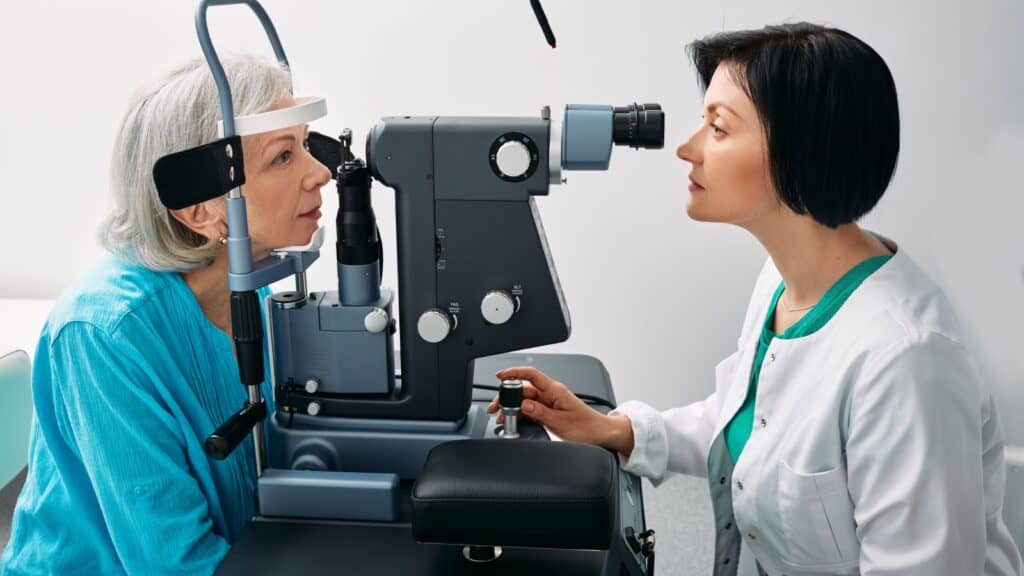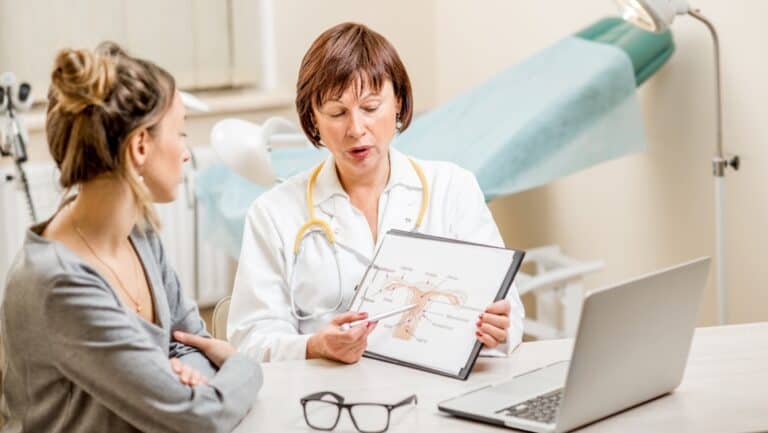A Simple Eye Exam Can Catch These Serious Diseases
It is easy to overlook routine health checks, and eye exams are often at the bottom of the list. However, regular eye exams are not just about checking if you need glasses; they are vital for detecting early signs of eye diseases and even some general health conditions. In this article, we’ll discuss why regular eye exams are essential, how often you should schedule them, what conditions can be identified during these exams, and the difference between an optometrist and an ophthalmologist.
Why Eye Exams Matter

The eyes are a window to your overall health. Eye exams can reveal more than just vision issues; they can uncover signs of underlying health problems, such as diabetes and high blood pressure. Eye exams assess the health of your eye tissues, nerves, and blood vessels, which can reflect the health of the body’s vascular and nervous systems. With many eye conditions and diseases progressing without symptoms, an eye exam is crucial for early detection and prevention.
Here Is What Regular Exams Cover

- Detect vision problems that may need correction, such as nearsightedness, farsightedness, or astigmatism.
- Identify eye diseases like glaucoma, cataracts, and age-related macular degeneration (AMD).
- Spot early signs of systemic conditions, such as diabetes, high blood pressure, and even certain types of cancer.
How Often Should You Get an Eye Exam?

The recommended frequency of eye exams varies by age, health, and risk factors. Here’s a general guideline:
- Children: Their first eye exam should be at 6 months, again at age 3, and then before starting school. After that, children with normal vision should have eye exams every 1-2 years.
- Adults (18-60 years): Every two years for those with good vision and no health concerns. Annual exams are recommended for those with risk factors, such as diabetes or a family history of eye disease.
- Adults (60+ years): Annually, as the risk of eye diseases increases with age.
For anyone with existing eye conditions or vision problems, more frequent exams may be necessary, as advised by an eye care professional.
Common Eye Diseases That Can Be Detected Early

Eye exams are not only for correcting vision but also for early detection of several serious eye diseases. Here are a few conditions an eye exam can reveal:
- Glaucoma: Known as the “silent thief of sight,” glaucoma often progresses without symptoms until significant vision loss has occurred. Eye exams can detect elevated eye pressure or optic nerve damage associated with glaucoma.
- Cataracts: Cataracts, a clouding of the eye’s lens, are common in older adults and can lead to vision impairment. Early detection helps plan for eventual treatment.
- Age-Related Macular Degeneration (AMD): This condition affects central vision and is a leading cause of vision loss in older adults. Regular eye exams can detect the early signs of AMD, allowing for treatments that can slow its progression.
- Diabetic Retinopathy: This is a complication of diabetes that damages the blood vessels in the retina. Eye exams can detect this condition before vision is affected, allowing for treatment that can prevent severe vision loss.
- Hypertension (High Blood Pressure): High blood pressure can cause changes in the blood vessels of the retina, which can be spotted during an eye exam. Detecting these changes can prompt early intervention to manage hypertension.
Systemic Conditions that Can Be Detected Through Eye Exams

Beyond eye health, eye exams can reveal signs of systemic diseases that may be silently developing in the body. For example:
- Diabetes: Small blood vessel leaks in the retina can indicate diabetes or prediabetes.
- High Cholesterol: A yellowish ring around the cornea can be a sign of high cholesterol.
- Autoimmune Diseases: Certain autoimmune diseases can cause inflammation in various parts of the eye.
- Certain Types of Cancer: Rarely, eye exams may reveal signs of certain cancers, such as lymphoma or leukemia, that can affect the eye area.
Optometrist vs. Ophthalmologist: What’s the Difference?

When scheduling an eye exam, it’s essential to know which type of eye care professional to see. Optometrists and ophthalmologists have different levels of training and focus on different aspects of eye care.
- Optometrist: An optometrist is a Doctor of Optometry (OD) and specializes in diagnosing vision problems, prescribing corrective lenses, and identifying early signs of eye diseases. Optometrists can treat certain eye conditions and prescribe medications, but they do not perform surgeries.
- Ophthalmologist: An ophthalmologist is a medical doctor (MD or DO) who specializes in eye and vision care, including performing eye surgeries. Ophthalmologists can diagnose and treat a wide range of eye diseases and conditions and can provide more specialized care if needed.
If you only need a routine eye exam or an updated prescription, an optometrist can help. However, if you have a complex eye disease, need surgery, or have a general health condition that impacts your vision, seeing an ophthalmologist may be necessary.
The Role of Technology in Eye Exams

Eye exams have advanced significantly with new technology, allowing for more accurate and less invasive evaluations. Tools such as Optical Coherence Tomography (OCT) provide high-resolution images of the retina, which can help detect and monitor conditions like glaucoma and AMD. Advanced retinal imaging also allows eye care providers to monitor blood vessels in the eye, providing insights into systemic health.
Signs You May Need an Eye Exam Sooner

Even with regular eye exams, certain symptoms indicate that you should see an eye doctor sooner. These include:
- Blurred or double vision
- Sudden loss of vision or visual disturbances
- Persistent eye pain or redness
- Flashes of light or floaters in your vision
- Chronic headaches or eye strain
If you experience any of these symptoms, it’s essential to consult an eye care professional as soon as possible. These can be signs of serious conditions that require immediate attention.
Taking Action to Protect Your Vision

Alongside regular eye exams, there are steps you can take daily to protect your vision:
- Use sunglasses: Protect your eyes from UV rays with sunglasses that block 100% of UVA and UVB rays.
- Eat a balanced diet: Foods rich in antioxidants, like leafy greens and fish, can support eye health.
- Practice the 20-20-20 rule: Every 20 minutes, take a 20-second break to look at something 20 feet away, especially if you spend long hours on digital devices.
- Avoid smoking: Smoking increases the risk of developing cataracts, AMD, and optic nerve damage.
Conclusion

Regular eye exams are a cornerstone of preventive healthcare. They not only safeguard your vision but can also provide insights into your overall health. By understanding the differences between optometrists and ophthalmologists, and knowing when and how often to get checked, you’re taking proactive steps to protect your vision and health. Whether you have perfect vision or need corrective lenses, make eye exams a priority and ensure that you’re seeing life’s moments clearly.
10 Ways To Tell If You Are Going Insane

Mental health concerns can manifest in various ways, and recognizing the signs of declining mental well-being is crucial for early intervention and support. From changes in sleep patterns and mood swings to social withdrawal and difficulty coping with daily life, there are several indicators that may suggest a person is experiencing serious mental health issues.
READ: 10 Ways To Tell If You Are Going Insane
Is Your Doctor Dismissing Your Symptoms? Here’s How to Deal with Medical Gaslighting

Medical gaslighting, where healthcare providers dismiss or minimize patients’ symptoms and concerns, can have severe consequences for both physical and mental well-being. Recognizing the signs of medical gaslighting and knowing how to respond are crucial skills for patients navigating the healthcare system.
This article explores the common indicators of medical gaslighting, legal protections available to patients, effective documentation strategies, and resources for those facing this challenging situation. By understanding these aspects, patients can better advocate for themselves and ensure they receive the quality care they deserve.
READ: Is Your Doctor Dismissing Your Symptoms? Here’s How to Deal with Medical Gaslighting
Join Us

Join us on this empowering journey as we explore, celebrate, and elevate “her story.” The Queen Zone is not just a platform; it’s a community where women from all walks of life can come together, share their experiences, and inspire one another. Welcome to a space where the female experience takes center stage. Sign up for our newsletter so you don’t miss a thing, Queen!







